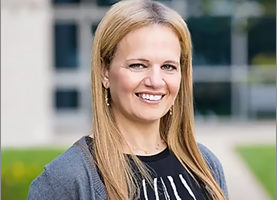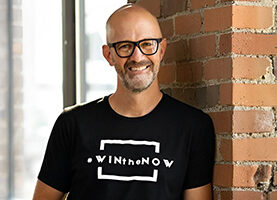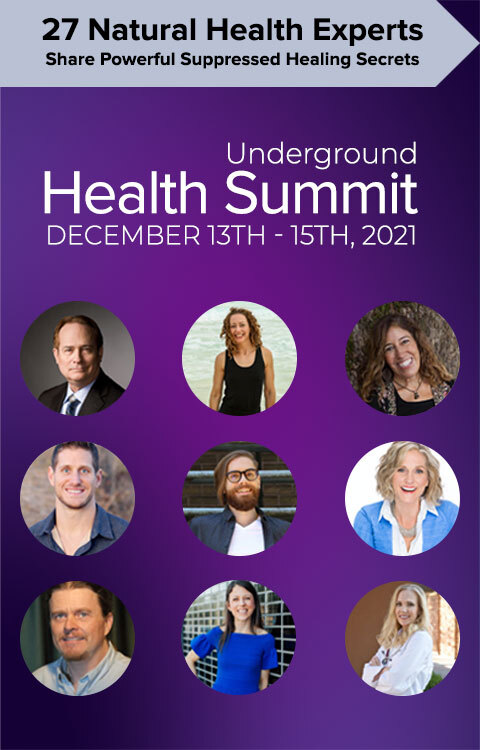
Support Us
Donations will be tax deductible
Chief Scientific Officer at Distributed Bio, Sawsan Youssef, joins the show to discuss her work at this unique company, and why it might hold promise for treating the COVID-19 virus and other medical conditions.
In this episode, you will learn:
Distributed Bio is a small, self-funded biotechnology company that’s creating new technologies for therapeutics in a variety of medical fields by using immunology as the platform. There are two type of therapeutics in their current portfolio: one that relies on antibody generation, and one that is vaccine-based. In response to the COVID-19 pandemic, Distributed Bio is developing a therapeutic which is based on the use of antibodies.
Youssef explains the science and biology behind how antibody therapy works and why the use of antibodies to combat viruses is not only effective, but less likely to cause dangerous side effects. Generally speaking, antibodies are a good type of therapeutic because they are well-tolerated by the body and target precisely what you’re aiming for. In contrast, the use of other small molecules in therapeutics might target what you’re aiming for, but they may also target multiple other pathways in the body along the way, leading to adverse effects.
Youssef discusses a number of other important topics, including how this technology could treat autoimmune diseases like lupus, the role of antibody therapeutics in the field of oncology, in what ways some viruses are able to render binding antibodies ineffective, and the timeframe on the COVID-19 therapeutic that’s in the works.
Press play for all the details, and learn more about these technologies at https://www.distributedbio.com/.
Available on Apple Podcasts: apple.co/2Os0myK
Richard Jacobs: Hello, this is Richard Jacobs with the Finding Genius podcast. I have Sawsan Youssef, she is the Chief Scientific Officer at Distributed Bio and we are going to talk about the work that she does there. So Sawsan, thanks for coming. How are you doing today?
Sawsan Youssef: Thanks for having me. I’m doing great
Richard Jacobs: Okay, good. So tell me first about Distributed Bio. What is the company about?
Sawsan Youssef: So, Distributed Bio is a very unique small biotech company that is based on immuno-engineering, basically engineering new technologies for developing new therapeutics in the field, in any medicinal field using immunology as the platform and generating different platforms to develop antibody therapeutics for from inflammation to cancer to viral vaccines and the uniqueness about Distributed Bio is that we are self-funded, so we don’t rely on venture capitalists, we support ourselves, so part of using these platforms as a way of generating our CRO services to generate antibody therapeutics using our unique platforms and technologies for other companies while we are developing our own internal portfolio.
So, in our internal portfolio, we have two types of therapeutics. One is, they are relying on antibody generation and one is vaccines. So, I’m pretty sure you guys also heard about us through the COVID 19 pandemic but for that, we are developing a therapeutic which is an antibody therapeutic and not vaccine but we also have these technologies for a flu vaccine or HIV vaccine that we are developing internally.
Richard Jacobs: Let’s talk about antibody therapy and vaccines. So, how would an antibody therapy work for any disease or condition?
Sawsan Youssef: So, antibodies are very; in therapeutic studies, there are two areas. There are small molecules and there are large molecules with antibodies. So antibodies actually are really good therapeutics in a way. They are very tolerable in the human body and their effects are directed against a target that you are aiming for. For example, if you have a molecule that is important that initiates cancer, for example, if you generate an antibody, for example, like HER2, you generate an antibody against that specific molecule so it targets specifically that molecule and the side effects will be very minimal versus if you give those patients a small molecule that affects many pathways so maybe the effect will be as strong but it will have a lot of outside scope side effects because it affects a lot of other pathways in parallel. But sometimes you don’t have a choice. You can’t find a molecule for this type of disease or not to target as an antibody therapeutic so you have to use a small molecule therapeutics. So, it depends on what target you want to aim for
Richard Jacobs: So, I’ve got a question here. How do antibodies work? Do they bind to a target and then they attract immune cells to engulf it? Do they choose to do some other action as well?
Sawsan Youssef: Yeah, so basically what the antibody does, you can engineer it and we are very good in that area as well. You engineer it based on what you want to aim to get out of the therapeutic. So, for example, if you want to block something, one molecule on the surface of cells, what you generate is an antibody that will block this molecule and this protein and stop the signaling downstream. So once the antibody and usually, the antibodies are made in such high affinity that you will prevent from other normal protein that bind this target in the body to bind because it’s bind so strong, that’s what it means by high affinity, you make it so strong that it will not let it until this molecule disappear, you won’t let it leave.
So, now, these antibodies can be engineered in many ways, in their profile to, if you want to induce like immune response, so you put this antibody into such a structure that it will recruit these into the other side where there is the side that binds the target and there is the other side that can induce the response that you want. So if you want to bring T-cells and B-cells and macrophages to kill this let’s say tumor cell, then you will engineer that antibody in a way that in the other side, while it’s binding the protein that we want to target, it will start this cascade of inflammation in immune response to generate this response. But if you just want it li8ke example, for COVID-19, for example, because if there is some thought that antibodies might cause an extra-inflammatory response.
So, you want to generate an antibody that just binds, for example, the virus and prevent it from infecting cells. So then you design other types of antibodies against other viruses. So you design it in a way that the antibody will bind the target and just block it from what it causes. Like for example, a virus to infect cells. So it depends on what you want to generate.
Richard Jacobs: I’ve heard that sometimes antibodies can be binding, they’ll bind to a target but sometimes it makes a target even more problematic and there are some that are neutralizing. So they will bind in such a way that they will stop the bacteria, the virus, or whatever it is from causing harm. So I guess that is the difference, right?
Sawsan Youssef: Yeah, so you generate; the sign that the antibody has like a Y shape. So, at the top of the Y shape, you have the binding of the targeted cell. So, on that side, you won’t change anything but the stem of the Y, you can mutate or you can make the antibody. Of course, it will be very similar to human antibodies because we know how exactly human antibodies look alike and there is multiple, there are different types and you design your therapeutics similar to what the human body generates but you can make some kind of an adjustment in that stem of the antibody to either cause, in the case of cancer, you want to bring a lot of immune cells to kill the cancer cells. So, in there, you generate that antibody, that will look exactly like the antibodies we generate, in general, in our bodies but you modify it in a way that it will cause the killing, for example, or if you want a neutralization, you generate an antibody in a form that it will give you de-neutralization only.
Richard Jacobs: so, I guess you’ve got to pick targets on the surface at certain spots and bind to them if you do it the right way. So what are some of the strategies? So, for like a virus, I guess you’d want to bind to the slight protein and not just to the capsid. What are some of the strategies to make an antibody work better in terms of where it binds or how it binds?
Sawsan Youssef: So, here in Distributed Bio, we’ve developed technologies that we can also generate multiple; first of all, we do our discovery process where we find those potential antibodies and based on functional assays that we test after we have this profile of antibodies, we choose the most probable part of this antibody to give us the optimal binding property in the optimal binding side because antibodies can bind different sides so you, after your discovery part, you set up several assays that you test and you pick. You pick your most probable candidates and then if you want them to bind very strong, we have different also, next step technologies where we kind of mutate cytes, endos antibodies and make them higher affinity or binding different epitopes or two epitopes at the same time like part of whatever protein we want to generate.
Then, after you finish that part of discovery, then you go ahead and you say, do I want to make the antibody just bind and neutralize or do I want to make the antibodies with some effective functions meaning like, causing the cells to die or and where will you plug the small parts of the discovery into the big backbone and then you have your final drug therapeutics and then you go through intensive assays and intensive detection assays to decide, okay, I think I chose this antibody because it binds this part of the target and I would like to have this function or prevent this function and that’s how you get to the final product that you move into the clinic later on.
Richard Jacobs: So, you make sure that the antibodies are as close as possible to natural antibodies, at least in terms of them also having the Y shape, similar size, and all that stuff?
Sawsan Youssef: No, you want the antibodies to be as close as to the human, it’s called germline meaning the human natural properties of antibodies because you don’t want these antibodies once you treat the patients with, to start the body within. If they are really different, the body then will be starting to see it as an anti-self and then it starts to generate another response against it and then reject the antibody. That’s very common sometimes but in antibody therapeutics, the side effects are very low because of the engineering and here at Distributed Bio, we are very good at it because we generate it in our library to eliminate those what is called immunogenicity parts from the antibodies, so the final products are very stable and very human-like, as we can get them. So, the probability that, again, it’s a person to person but the probability to get this side effect is very minimal.
Richard Jacobs: Are you saying that if you make the antibodies very unusual or different or alien, the body mounts a response and you may get an overreaction from the body and the person may get sick and die, let’s say?
Sawsan Youssef: No, they won’t get sick and die but they will have to stop the therapy; they will have some side effects like a rash or different, I mean each person will have or each therapeutic will have different side effects but again, they have to stop the therapy for them. So, in general, in companies and in knowing all these immune-engineering and the immunology of antibody therapeutics helps us primarily to generate antibodies that are as human as possible to avoid all and that’s where we excel because our founder and CEO Jacob Grenville had generated these antibody libraries and took in consideration all these problems of immunogenicity, of foreign or there are only antibodies real; so antibodies will work with only one type of population versus the other.
So, we eliminated all of that and we made our antibody libraries for discovery as human as possible and as general as possible, so it will lead us to the optimal. So we built ourselves for success to lead to the optimal discovery platform and we developed these technologies to be, the discovery part will go very fast; in like a month or less than a month to generate those preliminary pools of our antibodies to go quickly into screening and generate the final product.
Richard Jacobs: what is an example of a proper immune response and what is an example of an improper one? If you make the antibody just right, what will happen? Maybe a few details and if you don’t, what can happen?
Sawsan Youssef: So, it depends on what you want from the antibody and I will give you 3 examples. So, if you want an antibody against a target, let’s say that’s the easiest way. On cancer cells, like let’s give an example like HER2 for breast cancer, or let’s give an example for CV19 for leukemia. What you want from that antibody is to go bind that target and you want to bring as much as immune cells into that area where they can’t to kill the target, to generate the killing of the tumor cell. So you choose the antibody that binds its target the strongest and the most specific because sometimes our body generates proteins that are very similar between tissues. They are different but similar, so you want to have your antibody specific only for that target and you enhance that effect by having a Y shape that will, once this target binds, on the other side, it will bind to other immune cells that will start the inflammation like necrophages.
Necrophages go cloak T cells and B cells and then you start getting a huge immune response in the side of the tumor and you kill the tumor. There is other antibodies that you want them to bind immune cells and go, that’s what’s called immune-oncology and go bring those immune cells that; so what happens in general, let’s say when you haven’t and I’m talking in the cancer area right now but we can change it into inflammation as you flick the backbone and I will explain in a second. So, if you want to, let’s say, immune cells go, in general, to kill the tumor cells without any antibody therapeutics. So there what you do is, those cells started to get activated and start to kill the tumor but they are not, what we call exhausted. They are not good enough to finish the job because they get exhausted, because they start expressing some proteins that the tumor knows those proteins and they tell them okay, don’t continue.
So, in that case, we generate an antibody-like all the PV1 and CTLA4 that we are all, in the immune-oncology field that came out a few years ago and changed the whole concept of many cancers like lung cancer or bladder cancer or gastric cancer where basically, you go and this antibody will bind targets on your own immune cells that because you don’t want your immune cells to die because what happens here is just that the antibody will bind those molecules, they call it checkpoint where they stop the immune cells from acting. So those antibodies, you don’t want to have any, you just want them to bind the cells. So, once they bind like, the T cells, then the T cells will be like I need to start getting activated and multiply again and again and then you increase the immune cells in the tumor and immune impact the tumors.
So, here you basically blocked your exhausted immune cells from being exhausted and you facilitate them to kill the tumor themselves and that’s basically an antibody that you generated to just bind the target and tell the target stop. There are other antibodies that you actually want to increase the response. So basically it binds the target but it binds the target in an agonistic way meaning that it will bind the target and then tell the target, okay, I want you to start getting activated again and then, get the immune cells or get any other cells that you are attacking to respond to this target. It will see it as a lesion and it will start basically, to get activated again. So it’s all about the engineering of what you want, your antibody purpose tour and that’s how you just manage from binding the target and making it to the final human and making it to the essence that we want to generate.
Richard Jacobs: I got it. when the Y arms of the antibody bind, does it change the tail? Does it change the structure of the tail to make it active or inactive? Are you able to design to make it that way?
Sawsan Youssef: Yeah, it doesn’t change it, it depends on what tail it is attached to, but it has to bind the target first and then the tail will know what to do, it either will bind other cells or just block. But once the binding happens there is a little bit of conformational change there.
Richard Jacobs: So what happens, I’ve heard this with some viruses, that you, if it is only binding antibodies, it actually enhances the ability of the virus or allows it to find another way to enter cells and then it’s even worse than before. It’s like antibody modulated entry. Can you talk about that briefly?
Sawsan Youssef: what happens there, in that case, if new viruses are; so there are two ways. There are some viruses that are highly mutated that they, for example, flu virus, every year we have to get a new vaccine because they change there; rapidly mutate. So, if you generate one antibody against them or HIV viruses as well. They are highly mutated so if you generate an antibody against it, the replication of that virus, it changes very quickly, that they might change their own proteins in a way that antibodies will not be able to bind. So, in that case, you want to generate a vaccine that kind of gives you a large or a spectrum of vaccines that will recognize a different potential mutant that will give you a spectrum of protection.
There are some viruses that they don’t change very much in that protein but what happens is that they do have multiple proteins that can initiate the entry of the virus to the cells. So, if like, for example, the coronavirus, the new COVID-19 initiating disease virus, there is one side that we know but because it’s new, we don’t know how many other proteins will also facilitate the virus, facilitate the entry of the virus. So, in that case, just more research and more science need to be done to understand that. so that is for viruses that are known to have a few entries. So you either, again, generate a vaccine or you generate a combination of antibodies that block several proteins that helps the virus infiltrate the cells and you basically block all the possible entries to treat the patient if you are going into antibody therapeutic with a cocktail, as they did for Ebola, for example.
They gave a patient a cocktail of 3 antibodies, the Regeneron treatment and if their patients can really pass through the clinic, 94% of them survive which was a few years ago, a really bad pandemic. So, we need to understand the target very well in order for us to be able to design that optimal therapeutics for it.
Richard Jacobs: Makes sense. Let me tell you if I ask you anything and if it’s proprietary, then obviously, don’t answer, so they don’t know what is there. So, what’s the current work that you are doing that you think will be showing some promise? Moving forward, are very close to a breakthrough either with COVID or with other diseases or just, in general, making these antibody libraries, for some reason, somehow more effective than they currently are?
Sawsan Youssef: Yeah, so I can talk in general. I mean I’m pretty sure you guys heard of our COVID programs because it’s in the news. I mean, we are working to generate an antibody therapeutic. For it, we think we have interesting data that we will follow up on in the future with press releases, etc. and we are moving aggressively to going into first in human, hopefully, by end of August or September timeframes for; there are a few internal projects that I can’t talk about very much but I can just briefly touch base. Using our technologies and amazing libraries, we have a very interesting target in mind that might be relevant for heart auto-immune diseases like Lupus and arthritis, and our antibody therapeutic seems to be very promising.
But that will be, we are still in the development, because of the speed of COVID. COVID is already going really fast and we are preparing for a filing in the next few months for IND filing and going into a human. For other inflammatory diseases like lupus or arthritis, it might take a little bit longer but just because both COVID prioritized and it’s a long process. Usually, antibody therapeutic development take on normal, 18 months from discovery to going into first, a human. So, for that one, we are finalizing discovery and finalizing the final candidate and hopefully, in a year or so, we will be going into filing. There is another project that I am working on specifically and I won’t talk about it too much because it’s still proprietary but I’m working on finding a way that immune-oncology therapeutics are really helpful but not helpful for all diseases and we think we found a pathway to overcome that and use those immuno-therapeutics in cancer patients that don’t respond to them by giving them the supplementary technology that we are developing and so far, so good.
But that probably also will be a highlight in the next year or so because we are generating the data to prove it. so, we prove it in the first step, now we are proving it in the second step and so that project is really important for me because in my previous company I worked with amino oncology target, I generated a PD1 antibody and I noticed how patient and I was involved in clinical trials and I saw certain patients respond and certain not so I always think about the patients who don’t respond and I thought about it many times but I didn’t get to the idea until I moved here and I started thinking about it and studied about it and we just, we’ll see how it goes.
Richard Jacobs: I have a quick question about attacking tumors by attaching antibodies. Tumors are heterogeneous and I’m sure that the more that tumor goes along and metastasizes, the more heterogeneous it is. If you were to create a way to attach antibodies to it, I would think that you would need to have a cocktail of different antibodies because a given antibody would probably only attach to a given cell type, and once, they have differentiated away, they may need different antibodies. So you might only kill some of the cells of the tumor and not the other ones and the other chronal lineages would keep going.
Sawsan Youssef: That is totally correct and a lot of companies have done these studies but again, the tumor cells are so smart, they escape and those combination therapies right now are successful but not as was expected because the tumor has many faces and they are still learning about it. so, right now, the best combination is giving a checkpoint inhibitor with radiation or with chemotherapy but still, like the mixture of the antibodies, if they, like in my previous company and in much big pharma, they have tried this but it appears that if the tumor responds to an antibody, it will respond through the cocktail. If you want, you will maybe increase in the same population, the percentage of responders which is great but you won’t completely bring a different population that doesn’t respond unless you try with different therapeutics meaning like chemotherapy plus antibody or radiation plus antibody.
But, in my thinking that if this technology works, you just need to give that and then you need to keep following up with these antibodies and you can escape other harsher, risky treatments for the patients but this is still going on in the very beginning and hopefully we will see progress very soon and will decide how to move aggressively about it. so, with all the pandemics, a lot of patients still died from cancer, and not all cancer patients have the potential for all these therapeutics that are developed because they have something resistant in the tumors that those therapeutics are still not variant.
Richard Jacobs: Do you mind if I ask you about this for a few minutes. I didn’t ask you much about vaccines where we talked about attaching antibodies and causing immune responses properly but what that seems, can antibodies be used to bind and turn an invader into, to help the body create a memory of the invader so it becomes its own vaccine or how do vaccines work in regards to your work?
Sawsan Youssef: So, what you need the vaccine for is basically teach your immune system to develop those antibodies for the certain virus or certain bacteria or whatever you want it for or even there is a vaccine for cancer. You teach your immune system to generate those antibodies and develop them and go attack the bad invader, whether it’s a tumor cell or a virus or a bacteria or some parasite or whatever. The thing with vaccines is it’s built on your body has a memory which means sometimes you need to give multiple doses to give the antibodies. So you can educate yourselves that have never seen this foreign target to have an immune response and to treat this target and that would take at least a month or two months till you’ve built your immune response in the case of viral of a bacterial infection.
But in the case of a tumor, it might not be sufficient to eliminate because the tumor becomes sometimes metastasize or becomes very aggressive but it helps on top of the other therapeutics. But when you have a sick person, in the vaccine, you have to give them ahead of time like we all go to get the shot before the flu season because we want to either make new cells that will respond or we want to wake up the old cells that we had sitting in because they didn’t see that virus or that bacterial target and to activate it again. So it does what the antibody therapeutic does but it takes a longer time. But when you have like a sick person, for example, like in this pandemic, you want to do the vaccine part outside in a big facility that will generate these antibodies for human treatment and use. So you basically do that part of the education outside, by the technology, by the engineering outside of the body and you give the body that drug to block the disease quickly and not wait on the vaccine to work because some of these patients are really sick and they need some kind of therapy to block it on times.
So that’s basically the difference between vaccines and therapeutics. With antibody therapeutics, you try to block the disease or the infection’s agent exactly when you inject or in a day or less than a day or 48 hours. But for a vaccine, you basically educate your bodies that when the next wave comes, our body will be ready and by itself, fights with pathogens.
Richard Jacobs: Okay, very good. Sawsan, thanks for coming. It’s very interesting and how can people find out more about your work in Distributed Bio?
Sawsan Youssef: So, they can log in to our website, distributedbio.com or we also are having a spin-out called are we going to move all our therapeutics into the spin-out. So you can also look at us at cinevax.com either at the website or we have links at LinkedIn or Facebook or Instagram. So you can go to cinevax.com or distributedbio.com, on Twitter, on Facebook, on Instagram, LinkedIn, and find more information about us and about our company, the founders, and us and the research we do.
Richard Jacobs: Sawsan, I thank you for coming. I appreciate it.
Sawsan Youssef: Thank you.
Podcast: Play in new window | Download | Embed

What is the relationship between a hotel and the surrounding community? In what manners does it contribute positively, and in what ways does it potentially create competition? How does… Read More

In this episode, we connect with Olivier Momma, the Founder of Ekster. Ekster is a smart wallet company with a simple mission: to make better gear for life… Read More

Today, we connect with Randall Thompson, the president and founder of Dugout Mugs. Randall has a long history with baseball – including professional experience. By utilizing his love… Read More

Join us for an enlightening episode as we welcome Jon D. Levenson, the esteemed Albert A. List Professor of Jewish Studies at Harvard University and author of several… Read More

If you’ve ever felt like life is constantly presenting you with obstacle after obstacle, you’re not alone. You may ask yourself: How do I get unstuck to pursue… Read More







Subscribe to Our Newsletter
Get The Latest Finding Genius Podcast News Delivered To Your Inbox